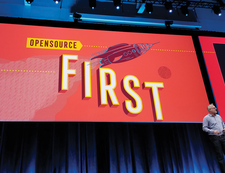How the OpenStack community is shaping the new Pike release
Changes at OpenStack

© Images courtesy of Swapnil Bhartiya
The quintessential open source cloud platform unveils a new development model with its latest release.
OpenStack has become boring. Boring is good in enterprise. It's a sign of maturity, stability, and consistent growth. OpenStack is showing all of that. However, it has also had its share of problems. With great adoption, comes great bloat. As OpenStack started getting deployed in new use cases, it started to see new projects being created by those users to address their own niche.
To maintain quality, the OpenStack project came out with an integrated release model, where new projects had to go through a vigorous incubation process. Once matured, they had to go through a voting process to become part of the integrated release. It didn't work out well, as many projects failed to meet the standards set by the OpenStack project. It was a dead end.
OpenStack tried to solve that problem in 2015 by moving away from an integrated release model to a Big Tent model. Under the Big Tent model, community members were free to work on their projects without having to worry about going through the incubating and voting process.
[...]
Buy this article as PDF
(incl. VAT)
Buy Linux Magazine
Subscribe to our Linux Newsletters
Find Linux and Open Source Jobs
Subscribe to our ADMIN Newsletters
Support Our Work
Linux Magazine content is made possible with support from readers like you. Please consider contributing when you’ve found an article to be beneficial.

News
-
Mozilla Plans to AI-ify Firefox
With a new CEO in control, Mozilla is doubling down on a strategy of trust, all the while leaning into AI.
-
Gnome Says No to AI-Generated Extensions
If you're a developer wanting to create a new Gnome extension, you'd best set aside that AI code generator, because the extension team will have none of that.
-
Parrot OS Switches to KDE Plasma Desktop
Yet another distro is making the move to the KDE Plasma desktop.
-
TUXEDO Announces Gemini 17
TUXEDO Computers has released the fourth generation of its Gemini laptop with plenty of updates.
-
Two New Distros Adopt Enlightenment
MX Moksha and AV Linux 25 join ranks with Bodhi Linux and embrace the Enlightenment desktop.
-
Solus Linux 4.8 Removes Python 2
Solus Linux 4.8 has been released with the latest Linux kernel, updated desktops, and a key removal.
-
Zorin OS 18 Hits over a Million Downloads
If you doubt Linux isn't gaining popularity, you only have to look at Zorin OS's download numbers.
-
TUXEDO Computers Scraps Snapdragon X1E-Based Laptop
Due to issues with a Snapdragon CPU, TUXEDO Computers has cancelled its plans to release a laptop based on this elite hardware.
-
Debian Unleashes Debian Libre Live
Debian Libre Live keeps your machine free of proprietary software.
-
Valve Announces Pending Release of Steam Machine
Shout it to the heavens: Steam Machine, powered by Linux, is set to arrive in 2026.

